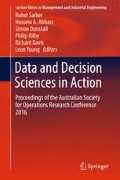Abstract
We present a methodological framework for the evaluation and comparison of surface spray fragmentation patterns from a range of medium-calibre air bursting munitions. The methodology is underpinned by both analytic and probabilistic modelling techniques. In particular, we present a fly-out model for the calculation of the terminal speed of a fragment on the impact plane. The fly-out model constitutes a trade-off between the computational efficiency of analytic models and the accuracy of detailed numerical methods extant in the literature. The methodology has been developed with the ability to readily adapt to modifications in the gun and ammunition parameters, with applications to controlled and naturally fragmenting munitions, as well as shrapnel-based warheads. This is demonstrated by comparing the surface spray patterns of two different ammunition types.
Access this chapter
Tax calculation will be finalised at checkout
Purchases are for personal use only
Notes
- 1.
- 2.
- 3.
The Improved Kinetic Energy—Electronically Timed advanced shotgun projectile.
- 4.
These models, which include detailed atmospheric data, usually require advanced numerical methods (e.g. fourth order Runge-Kutta) for their solution (see [5]).
- 5.
Also known as the injury criterion for anti-personnel applications [14].
- 6.
To verify that the polar representation describes the same conical surface, the components may be substituted into the known cartesian equation given in Eq. (2). This can be verified with a computational algebra software package such as MAPLE®.
- 7.
For example, the cross-sectional area of a spherical fragment is \(A = \pi d^2/4\), where d is the diameter.
- 8.
See Chap. 8 of Carlucci and Jacobson [3] for further details on the approximation of drag profiles by analytic functions.
- 9.
Produced in MATLAB®.
- 10.
For example, comparing the hyper-ballistic trajectories to standard trajectories.
- 11.
This is the so-called fragmentation blooming effect.
References
Bland, G.: The development and testing of the improved kinetic energy electronic time (IKE-ET) round. In: Proceedings of the 2015 Armament Systems Forum. Defense Technical Information Center (2015)
Boon, J.K.: Probabilistic Models for Artillery Tactical Effects with Fragmentation Rounds. Technical Report DSTO-TR-1767. Defence Science and Technology Organisation, Edinburgh, South Australia (2005)
Carlucci, D.E., Jacobson, S.S.: Ballistics: Theory and Design of Guns and Ammunition. CRC Press, Boca Raton, Florida (2008)
Catovic, A., Zecevic, B., Serdarevic, S., Terzic, J.: Numerical simulations for prediction of aerodynamic drag on high velocity fragments from naturally fragmenting high explosive warheads. In: Proceedings of the 15th Seminar of New Trends in Research of Energetic Materials. Part II, pp. 475–484. University of Pardubice, Pardubice, Czech Republic (2012)
Chircop, P.: Projectile Trajectory Modelling for Surface Gunfire. Technical Note DSTO-TN-0914. Defence Science and Technology Organisation, Edinburgh, South Australia (2009)
Driels, M.R.: Weaponeering: Conventional Weapon Systems Effectiveness, 2nd edn. American Institute of Aeronautics and Astronautics Inc., Reston, Virginia (2013)
Gurney, R.M.: The Initial Velocities of Fragments from Bombs, Shell and Grenades. Technical Report, Defense Technical Information Center (1943)
Jelic, Z., Zagorecki, A., Hameed, A., Nandeecha, S.: Fragmentation and lethality analysis tool for natural and controlled fragmentation, and pre-fragmented warheads. In: Proceedings of the 27th International Symposium on Ballistics, pp. 665–675. Freiburg, Germany (2013)
Lloyd, R.M.: Conventional Warhead Systems Physics and Engineering Design. American Institute of Aeronautics and Astronautics Inc. (1998)
Miller, D.G., Bailey, A.B.: Sphere drag at Mach numbers from 0.3 to 2.0 at Reynolds numbers approaching 107. J. Fluid Mech. 93(3):449–464. Cambridge University Press (1979)
Mott, N.F.: A Theory of the fragmentation of shells and bombs. In: Fragmentation of Rings and Shells: The Legacy of N.F. Mott, pp. 243–294. Springer, Heidelberg (2006)
Nelhiebel, A., Paul, W.: Soldier vulnerability model. In: Proceedings of the 27th International Symposium on Ballistics, pp. 637–647. Freiburg, Germany (2013)
Payne, C.: Principles of Naval Weapon Systems, 2nd edn. United States Naval Institute, Annapolis, Maryland (2010)
Zaker, T.A.: Fragment and Debris Hazards. Technical Report, Defense Technical Information Center (1975)
Author information
Authors and Affiliations
Corresponding author
Editor information
Editors and Affiliations
Rights and permissions
Copyright information
© 2018 Springer International Publishing AG
About this paper
Cite this paper
Chircop, P.A. (2018). Analytic and Probabilistic Techniques for the Determination of Surface Spray Patterns from Air Bursting Munitions. In: Sarker, R., Abbass, H., Dunstall, S., Kilby, P., Davis, R., Young, L. (eds) Data and Decision Sciences in Action. Lecture Notes in Management and Industrial Engineering. Springer, Cham. https://doi.org/10.1007/978-3-319-55914-8_9
Download citation
DOI: https://doi.org/10.1007/978-3-319-55914-8_9
Published:
Publisher Name: Springer, Cham
Print ISBN: 978-3-319-55913-1
Online ISBN: 978-3-319-55914-8
eBook Packages: EngineeringEngineering (R0)

